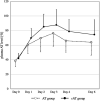Comparison of Protective Effects of Recombinant Antithrombin Gamma and Plasma-Derived Antithrombin on Sepsis-Induced Disseminated Intravascular Coagulation and Multiple Organ Failure
- PMID: 33332196
- PMCID: PMC7750769
- DOI: 10.1177/1076029620981630
Comparison of Protective Effects of Recombinant Antithrombin Gamma and Plasma-Derived Antithrombin on Sepsis-Induced Disseminated Intravascular Coagulation and Multiple Organ Failure
Abstract
In Japan, the dose of the new recombinant antithrombin III concentrate (rAT-gamma) is titrated according to patient body weight (BW), while conventional plasma-derived antithrombin concentrates (AT) are administered as a fixed dose. Therefore, it is anticipated that rAT-gamma could produce better treatment effects than AT. The aim of this study was to compare the organ protective effects of doses of rAT-gamma and AT administered in clinical practice for septic disseminated intravascular coagulation (DIC) and multiple organ failure. This study was performed at a single university hospital in Japan. A total of 49 patients with antithrombin deficiency secondary to septic DIC who were administered either rAT-gamma (n = 26) or AT (n = 23) were retrospectively analyzed to assess the dose of supplemental antithrombin concentrates, plasma antithrombin activity, Japanese Association for Acute Medicine (JAAM)-DIC score, and modified Sequential Organ Failure Assessment (SOFA) score on days 0, 3 and 6. The AT-equivalent dose per kg BW of rAT-gamma (equal to the initial rAT-gamma dose per kg BW divided by 1.2) was significantly higher than the dose per kg BW of AT (AT 23.4 ± 5.1 vs. rAT 28.9 ± 3.9 IU/kg/day; P < 0.001). Consequently, serial increases in plasma antithrombin levels occurred more rapidly in the rAT-gamma group (P = 0.036). JAAM DIC and modified SOFA scores revealed significantly greater improvement in the rAT versus the AT group (JAAM DIC score: P = 0.042, mSOFA score: P = 0.005). The results of this study suggest that AT supplementation adjusted for patient BW might further improve septic DIC and multiple organ failure.
Keywords: antithrombin III; disseminated intravascular coagulation; recombinant antithrombin gamma; sepsis; sequential organ failure assessment score.
Conflict of interest statement
Figures




Similar articles
-
A randomized, controlled, multicenter trial of the effects of antithrombin on disseminated intravascular coagulation in patients with sepsis.Crit Care. 2013 Dec 16;17(6):R297. doi: 10.1186/cc13163. Crit Care. 2013. PMID: 24342495 Free PMC article. Clinical Trial.
-
A Suggested Link Between Antithrombin Dose and Rate of Recovery from Disseminated Intravascular Coagulation in Patients with Severe Organ Failure.Clin Appl Thromb Hemost. 2022 Jan-Dec;28:10760296221080942. doi: 10.1177/10760296221080942. Clin Appl Thromb Hemost. 2022. PMID: 35187966 Free PMC article.
-
Impact of Antithrombin Activity Levels Following Recombinant Antithrombin Gamma Therapy in Patients with Sepsis-Induced Disseminated Intravascular Coagulation.Clin Appl Thromb Hemost. 2022 Jan-Dec;28:10760296221135790. doi: 10.1177/10760296221135790. Clin Appl Thromb Hemost. 2022. PMID: 36380520 Free PMC article.
-
Present and future of anticoagulant therapy using antithrombin and thrombomodulin for sepsis-associated disseminated intravascular coagulation: a perspective from Japan.Int J Hematol. 2016 Mar;103(3):253-61. doi: 10.1007/s12185-015-1904-z. Epub 2015 Nov 20. Int J Hematol. 2016. PMID: 26588929 Review.
-
Clinical practice guidelines for management of disseminated intravascular coagulation in Japan 2024. Part 1: sepsis.Int J Hematol. 2025 May;121(5):592-604. doi: 10.1007/s12185-024-03896-9. Epub 2024 Dec 16. Int J Hematol. 2025. PMID: 39676120 Review.
Cited by
-
Proposal of Quick Diagnostic Criteria for Disseminated Intravascular Coagulation.J Clin Med. 2022 Feb 16;11(4):1028. doi: 10.3390/jcm11041028. J Clin Med. 2022. PMID: 35207302 Free PMC article.
-
Research Progress of Macromolecules in the Prevention and Treatment of Sepsis.Int J Mol Sci. 2023 Aug 21;24(16):13017. doi: 10.3390/ijms241613017. Int J Mol Sci. 2023. PMID: 37629199 Free PMC article. Review.
-
The antithrombin activity recovery after substitution therapy is associated with improved 28-day mortality in patients with sepsis-associated disseminated intravascular coagulation.Thromb J. 2023 Nov 2;21(1):112. doi: 10.1186/s12959-023-00556-6. Thromb J. 2023. PMID: 37919722 Free PMC article.
-
Proteomic-Based Platelet Activation-Associated Protein SELP May Be a Novel Biomarker for Coagulation and Prognostic in Essential Thrombocythemia.J Clin Med. 2023 Jan 30;12(3):1078. doi: 10.3390/jcm12031078. J Clin Med. 2023. PMID: 36769725 Free PMC article.
-
Antithrombin and Its Role in Host Defense and Inflammation.Int J Mol Sci. 2021 Apr 20;22(8):4283. doi: 10.3390/ijms22084283. Int J Mol Sci. 2021. PMID: 33924175 Free PMC article. Review.
References
-
- Semeraro N, Ammollo CT, Semeraro F, Colucci M. Sepsis, thrombosis and organ dysfunction. Thromb Res. 2012;129(3):290–295. - PubMed
-
- Levi M, Ten Cate H. Disseminated intravascular coagulation. N Engl J Med. 1999;341:586–592. - PubMed
-
- Opal SM. Interactions between coagulation and inflammation. Scand J Infect Dis. 2003;35(9):545–554. - PubMed
-
- Levi M, Poll TV. Coagulation in patients with severe sepsis. Semin Thromb Hemost. 2015;41(1):9–15. - PubMed
Publication types
MeSH terms
Substances
LinkOut - more resources
Full Text Sources
Medical

